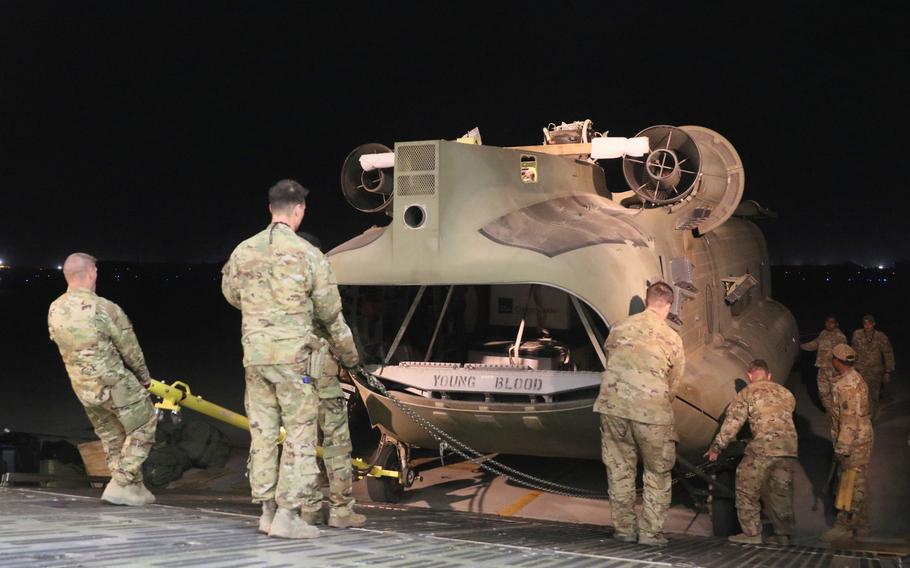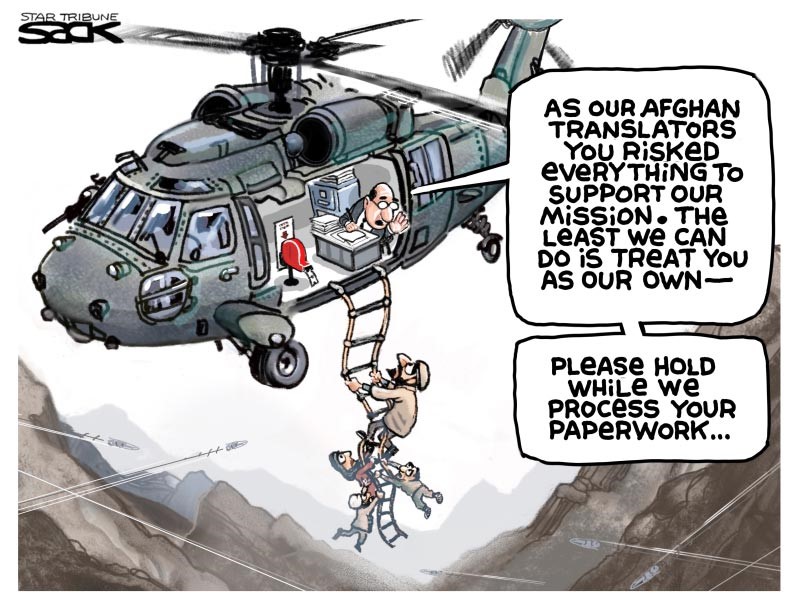
UPDATE II:
As is often the case, a “cartoon” (hate to use that term when referring to what could become a humanitarian tragedy) says it all:

UPDATE I:
In announcing on Thursday that the military mission in Afghanistan will end Aug. 31, President Biden also briefly addressed the plight of Afghan interpreters and other Afghans who aided U.S. troops at great peril to themselves.
“Our message to those women and men is clear. There is a home for you in the United States. … We will stand with you, just as you stood with us,” Biden promised.
But details were sketchy.
A mere 2,500 Special Immigrant Visa applications have been approved this year offering safe passage to the U.S. for these Afghan allies.
The U.S. would be conducting flights for Afghan allies this month before the U.S. military mission concludes, housing some in third-party countries temporarily.
However, the president did not provide details about which neighboring countries would agree to temporarily host the evacuated Afghans.
Neither Pentagon Presse Secretary John Kirby Kirby nor White House press secretary Jen Psaki would provide additional details.
Original Post:
As our great nation celebrates the 245th anniversary of our Independence, let us not forget a country that a little more than one hundred years ago celebrated its independence from British influence, yet – during the past four decades — has seen very little independence from conflict, ethnic, religious and regional warfare, and — as Faiz Ahmed puts it — from “great-power politics and “superpower blunders,” including our own longest war.
As foreign troops, including the U.S., have effectively withdrawn from the war-torn country, no one knows what the 102nd anniversary of Afghanistan’s Independence, its jeshn, on August 19, will bring to its long-suffering people.
Especially fraught with uncertainty and risk is the fate that awaits those thousands of brave Afghan men and women who have risked their lives by working with U.S. military and government officials and who believed in America’s honor and promises to protect them if and when the time came when they could become the targets of the Taliban and other terrorist and criminal groups.
Well, the time to honor that promise is now.
Grim headlines like “As Afghan Forces Crumble, Air of Unreality Grips the Capital,” and “The Impending Fall of Afghanistan” tell us that time is not on our nor the Afghans’ side.
Still, America continues to debate, to “develop options,” and to “make plans” on how and when to evacuate these desperate people.
Way back, on Feb. 4, President Biden signed an executive order with a provision giving the State Department six months to review and make recommendations on the Special Immigrant Visas (SIV) program.
This was before his announcement on April 14 that the U.S. would withdraw all remaining troops from Afghanistan by Sept. 11 and long, long before the most recent acceleration of our withdrawal from Afghanistan.
When there were still some 100 days left until the U.S. withdrawal, advocates noted that it was already too late “to rely on the visa program to save allies threatened by the Taliban.” That, it was time to use massive airlifts – more than 300 flights of U.S. transport aircraft, one advocate suggested – to evacuate the Afghans. Moreover, if the military were planning to withdraw by July 4 – which it is now effectively doing — the “the evacuation would require seven flights per day…”
Where are those flights?
Options were being “developed” and plans were being “formulated.”
Guam was considered as an interim location to process vulnerable Afghans and their families – approximately 70,000 of them.
While we were “planning,” other NATO allies who fought alongside our troops in Afghanistan have evacuated hundreds of Afghans and have announced policies to make it easier for interpreters to apply for asylum.
More recently:
As pressure grew for Congress and the administration to do more than just “planning,” the U.S. House of Representatives, with significant bipartisan support, passed legislation intended to streamline and speed up the bureaucratic SIV process for Afghans who worked for the American military.
A bipartisan group of 22 lawmakers called for the White House to begin “immediately” transporting allies to a safe zone such as Guam to ensure their safety.
The Biden administration, once again, said it was creating evacuation plans with Biden promising, “Afghans who helped us are not going to be left behind.” “Reuters is reporting that the Biden administration is exploring having three Central Asian countries temporarily take in thousands of Afghans who worked with U.S. forces.
On Thursday, a senior Republican lawmaker said plans to evacuate at-risk Afghans will include their family members for a total of as many as 50,000 people.
And on Friday, White House spokeswoman Jen Psaki, without providing further details said, “certainly our timeline is to relocate these individuals to a location outside of Afghanistan before we complete our military drawdown…”
With our total withdrawal from Afghanistan imminent and with the Taliban rapidly advancing, the clock has run out on looking at options and formulating plans. It is time to execute those plans post haste.
While we may have finally reached the end of that 20-year-long tunnel, we should not, cannot, turn out the light until we have fulfilled that sacred promise to those who helped us travel through that long, costly, lethal tunnel.
















